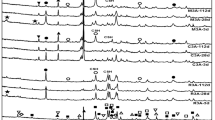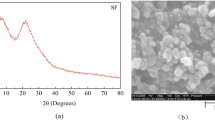Abstract
Magnesium chloride (MgCl2) reacts with cement pastes resulting in calcium leaching and the formation of calcium oxychloride, which can cause damage. This paper examines the damage in different cement pastes exposed to MgCl2 solutions. Volume change measurement and low temperature differential scanning calorimetry are used to characterize the formation of calcium oxychloride. Thermogravimetric analysis and X-ray fluorescence are used to quantify calcium leaching from Ca(OH)2 and C-S-H. The ball-on-three-balls test is used to quantify the flexural strength reduction. Calcium oxychloride can form in cement pastes exposed to MgCl2 solutions with a (Ca(OH)2/MgCl2) molar ratio larger than 1. As the MgCl2 concentration increases, two-stages of flexural strength reduction are observed in the plain cement pastes, with the initial reduction primarily due to calcium leaching from Ca(OH)2 and the additional reduction due to the calcium leaching from C-S-H (at MgCl2 concentrations above 17.5 wt%). For the cement pastes containing fly ash, there is a smaller reduction in flexural strength as less Ca(OH)2 is leached, while no additional reduction is observed at high MgCl2 concentrations due to the greater stability of C-S-H with a lower Ca/Si ratio. The addition of fly ash can mitigate damage in the presence of MgCl2 solutions.











Similar content being viewed by others
References
Yehia S, Tuan CY (1998) Bridge deck deicing. In: Transportation conference proceedings. Iowa State University, Ames, pp 51–57
Fischel M (2001) Evaluation of selected deicers based on a review of the literature CDOT-DTD-R-2001-15. Colorado Department of Transportation, Denver
Mussato BT, Gepraegs OK, Farnden G (2004) Relative effects of sodium chloride and magnesium chloride on reinforced concrete: state of the art. Transp Res Rec 1866:59–66. https://doi.org/10.3141/1866-08
Page CL, Short NR, El Tarras A (1981) Diffusion of chloride ions in hardened cement pastes. Cem Concr Res 11(3):395–406. https://doi.org/10.1016/0008-8846(81)90111-3
Nielsen EP, Geiker MR (2003) Chloride diffusion in partially saturated cementitious material. Cem Concr Res 33(1):133–138. https://doi.org/10.1016/s0008-8846(02)00939-0
Qiao C, Ni W, Wang Q, Weiss J (2018) Chloride diffusion and wicking in concrete exposed to NaCl and MgCl2 solutions. J Mater Civ Eng 30(3):04018015. https://doi.org/10.1061/(ASCE)MT.1943-5533.0002192
Nagataki S, Otsuki N, Wee T-H, Nakashita K (1993) Condensation of chloride ion in hardened cement matrix materials and on embedded steel bars. ACI Mater J 90(4):323–332
Raupach M (2006) Models for the propagation phase of reinforcement corrosion—an overview. Mater Corros 57(8):605–613. https://doi.org/10.1002/maco.200603991
Thomas MDA, Bamforth PB (1999) Modelling chloride diffusion in concrete: effect of fly ash and slag. Cem Concr Res 29(4):487–495. https://doi.org/10.1016/s0008-8846(98)00192-6
Tang L (2008) Engineering expression of the ClinConc model for prediction of free and total chloride ingress in submerged marine concrete. Cem Concr Res 38(8–9):1092–1097. https://doi.org/10.1016/j.cemconres.2008.03.008
Tumidajski PJ, Chan GW (1996) Durability of high performance concrete in magnesium brine. Cem Concr Res 26(4):557–565. https://doi.org/10.1016/0008-8846(96)00034-8
Peterson K, Julio-Betancourt G, Sutter L, Hooton RD, Johnston D (2013) Observations of chloride ingress and calcium oxychloride formation in laboratory concrete and mortar at 5 °C. Cem Concr Res 45:79–90. https://doi.org/10.1016/j.cemconres.2013.01.001
Mesbah A, François M, Cau-dit-Coumes C, Frizon F, Filinchuk Y, Leroux F, Ravaux J, Renaudin G (2011) Crystal structure of Kuzel’s salt 3CaO·Al2O3·1/2CaSO4·1/2CaCl2·11H2O determined by synchrotron powder diffraction. Cem Concr Res 41(5):504–509. https://doi.org/10.1016/j.cemconres.2011.01.015
Birnin-Yauri UA, Glasser FP (1998) Friedel’s salt, Ca2Al(OH)6(Cl, OH)·2H2O: its solid solutions and their role in chloride binding. Cem Concr Res 28(12):1713–1723. https://doi.org/10.1016/S0008-8846(98)00162-8
Bilinski H, MatkoviĆ B, MaŽUraniĆ C, ŽUniĆ TB (1984) The formation of magnesium oxychloride phases in the systems MgO–MgCl2–H2O and NaOH–MgCl2–H2O. J Am Ceram Soc 67(4):266–269. https://doi.org/10.1111/j.1151-2916.1984.tb18844.x
Dehua D, Chuanmei Z (1996) The effect of aluminate minerals on the phases in magnesium oxychloride cement. Cem Concr Res 26(8):1203–1211. https://doi.org/10.1016/0008-8846(96)00101-9
Sutter L, Peterson K, Touton S, Van Dam T, Johnston D (2006) Petrographic evidence of calcium oxychloride formation in mortars exposed to magnesium chloride solution. Cem Concr Res 36(8):1533–1541. https://doi.org/10.1016/j.cemconres.2006.05.022
Bernard E, Lothenbach B, Le Goff F, Pochard I, Dauzères A (2017) Effect of magnesium on calcium silicate hydrate (C-S-H). Cem Concr Res 97:61–72. https://doi.org/10.1016/j.cemconres.2017.03.012
Gaitero JJ, Campillo I, Guerrero A (2008) Reduction of the calcium leaching rate of cement paste by addition of silica nanoparticles. Cem Concr Res 38(8–9):1112–1118. https://doi.org/10.1016/j.cemconres.2008.03.021
Haga K, Shibata M, Hironaga M, Tanaka S, Nagasaki S (2005) Change in pore structure and composition of hardened cement paste during the process of dissolution. Cem Concr Res 35(5):943–950. https://doi.org/10.1016/j.cemconres.2004.06.001
Haga K, Sutou S, Hironaga M, Tanaka S, Nagasaki S (2005) Effects of porosity on leaching of Ca from hardened ordinary Portland cement paste. Cem Concr Res 35(9):1764–1775. https://doi.org/10.1016/j.cemconres.2004.06.034
Carde C, François R (1999) Modelling the loss of strength and porosity increase due to the leaching of cement pastes. Cement Concr Compos 21(3):181–188. https://doi.org/10.1016/S0958-9465(98)00046-8
Carde C, François R (1997) Effect of the leaching of calcium hydroxide from cement paste on mechanical and physical properties. Cem Concr Res 27(4):539–550. https://doi.org/10.1016/S0008-8846(97)00042-2
Heukamp FH, Ulm FJ, Germaine JT (2001) Mechanical properties of calcium-leached cement pastes: triaxial stress states and the influence of the pore pressures. Cem Concr Res 31(5):767–774. https://doi.org/10.1016/S0008-8846(01)00472-0
Carde C, François R, Torrenti J-M (1996) Leaching of both calcium hydroxide and C-S-H from cement paste: modeling the mechanical behavior. Cem Concr Res 26(8):1257–1268. https://doi.org/10.1016/0008-8846(96)00095-6
Farnam Y, Wiese A, Bentz D, Davis J, Weiss J (2015) Damage development in cementitious materials exposed to magnesium chloride deicing salt. Constr Build Mater 93:384–392. https://doi.org/10.1016/j.conbuildmat.2015.06.004
Qiao C, Suraneni P, Weiss J (2018) Flexural strength reduction of cement pastes exposed to CaCl2 solutions. Cement Concr Compos 86:297–305. https://doi.org/10.1016/j.cemconcomp.2017.11.021
Cao Y, Zavaterri P, Youngblood J, Moon R, Weiss J (2015) The influence of cellulose nanocrystal additions on the performance of cement paste. Cement Concr Compos 56:73–83. https://doi.org/10.1016/j.cemconcomp.2014.11.008
Todd NT (2015) Assessing risk reduction of high early strength concrete mixtures. Purdue University, West Lafayette
Qiao C, Suraneni P, Tsui Chang M, Weiss J (2018) The influence of calcium chloride on flexural strength of cement-based materials. In: Hordijk DA, Luković M (eds) High tech concrete: where technology and engineering meet: proceedings of the 2017 fib symposium, held in Maastricht, The Netherlands, June 12–14, 2017. Springer International Publishing, Cham, pp 2041–2048. https://doi.org/10.1007/978-3-319-59471-2_233
Qiao C, Suraneni P, Weiss J (2017) Measuring volume change due to calcium oxychloride phase transformation in a Ca(OH)2–CaCl2–H2O system. Adv Civ Eng Mater 6(1):157–169. https://doi.org/10.1520/ACEM20160065
Fu T, Deboodt T, Ideker JH (2012) Simple procedure for determining long-term chemical shrinkage for cementitious systems using improved standard chemical shrinkage test. J Mater Civ Eng 24(8):989–995. https://doi.org/10.1061/(ASCE)MT.1943-5533.0000486
Monical J, Unal E, Barrett T, Farnam Y, Weiss WJ (2016) Reducing joint damage in concrete pavements. Transp Res Rec J Transp Res Board 2577:17–24. https://doi.org/10.3141/2577-03
AASHTO (2017) Standard method of test for quantifying calcium oxychloride amounts in cement pastes exposed to deicing salts. AASHTO, Washington
Börger A, Supancic P, Danzer R (2004) The ball on three balls test for strength testing of brittle discs: part II: analysis of possible errors in the strength determination. J Eur Ceram Soc 24(10–11):2917–2928. https://doi.org/10.1016/j.jeurceramsoc.2003.10.035
Shi Z, Geiker MR, De Weerdt K, Østnor TA, Lothenbach B, Winnefeld F, Skibsted J (2017) Role of calcium on chloride binding in hydrated Portland cement–metakaolin–limestone blends. Cem Concr Res 95:205–216. https://doi.org/10.1016/j.cemconres.2017.02.003
Kim T, Olek J (2012) Effects of sample preparation and interpretation of thermogravimetric curves on calcium hydroxide in hydrated pastes and mortars. Transp Res Rec J Transp Res Board 2290:10–18. https://doi.org/10.3141/2290-02
Chang MT, Suraneni P, Isgor OB, Trejo D, Weiss WJ (2017) Using X-ray fluorescence to assess the chemical composition and resistivity of simulated cementitious pore solutions. Int J Adv Eng Sci Appl Math 9(3):136–143. https://doi.org/10.1007/s12572-017-0181-x
Qiao C, Suraneni P, Weiss J (2018) Phase diagram and volume change of the Ca(OH)2–CaCl2–H2O system for varying Ca(OH)2/CaCl2 molar ratios. J Mater Civ Eng 30(2):04017281. https://doi.org/10.1061/(ASCE)MT.1943-5533.0002145
Stillinger FH (1995) A topographic view of supercooled liquids and glass formation. Science 267(5206):1935. https://doi.org/10.1126/science.267.5206.1935
Qiao C, Suraneni P, Weiss J (2018) Damage in cement pastes exposed to NaCl solutions. Constr Build Mater 171:120–127. https://doi.org/10.1016/j.conbuildmat.2018.03.123
Shi Z, Geiker MR, Lothenbach B, De Weerdt K, Garzón SF, Enemark-Rasmussen K, Skibsted J (2017) Friedel’s salt profiles from thermogravimetric analysis and thermodynamic modelling of Portland cement-based mortars exposed to sodium chloride solution. Cement Concr Compos 78:73–83. https://doi.org/10.1016/j.cemconcomp.2017.01.002
Patnaik P (2003) Handbook of inorganic chemicals, vol 529. McGraw-Hill, New York
Brown ME (2001) Introduction to thermal analysis: techniques and applications, vol 1. Springer, Berlin
Richardson IG (1999) The nature of C-S-H in hardened cements. Cem Concr Res 29(8):1131–1147. https://doi.org/10.1016/S0008-8846(99)00168-4
Richardson IG (2004) Tobermorite/jennite- and tobermorite/calcium hydroxide-based models for the structure of C-S-H: applicability to hardened pastes of tricalcium silicate, β-dicalcium silicate, Portland cement, and blends of Portland cement with blast-furnace slag, metakaolin, or silica fume. Cem Concr Res 34(9):1733–1777. https://doi.org/10.1016/j.cemconres.2004.05.034
Faucon P, Le Bescop P, Adenot F, Bonville P, Jacquinot JF, Pineau F, Felix B (1996) Leaching of cement: study of the surface layer. Cem Concr Res 26(11):1707–1715. https://doi.org/10.1016/S0008-8846(96)00157-3
Acknowledgements
The authors gratefully acknowledge financial support from the National Ready Mix Concrete Association (NRMCA), the Portland Cement Association (PCA), MIT Concrete Sustainability Hub and a pooled fund by the Oklahoma Department of Transportation (TP-5(297)) “Improving Specifications to Resist Frost Damage in Modern Concrete”. The authors also acknowledge insightful discussions with Dr. Vahid Jafari Azad and Professor O. Burkan Isgor at Oregon State University. The authors also acknowledge the hard work by Myo Thiha Zaw for B3B specimen preparation.
Funding
This study was funded by the National Ready Mix Concrete Association (NRMCA), the Portland Cement Association (PCA), MIT Concrete Sustainability Hub and a pooled fund by the Oklahoma Department of Transportation (TP-5(297)) “Improving Specifications to Resist Frost Damage in Modern Concrete”.
Author information
Authors and Affiliations
Corresponding author
Ethics declarations
Conflict of interest
The authors declare that they have no conflict of interest.
Rights and permissions
About this article
Cite this article
Qiao, C., Suraneni, P., Tsui Chang, M. et al. Damage in cement pastes exposed to MgCl2 solutions. Mater Struct 51, 74 (2018). https://doi.org/10.1617/s11527-018-1191-2
Received:
Accepted:
Published:
DOI: https://doi.org/10.1617/s11527-018-1191-2




